What Equipment Does a Bakery Need? Essential Bakery Equipment List
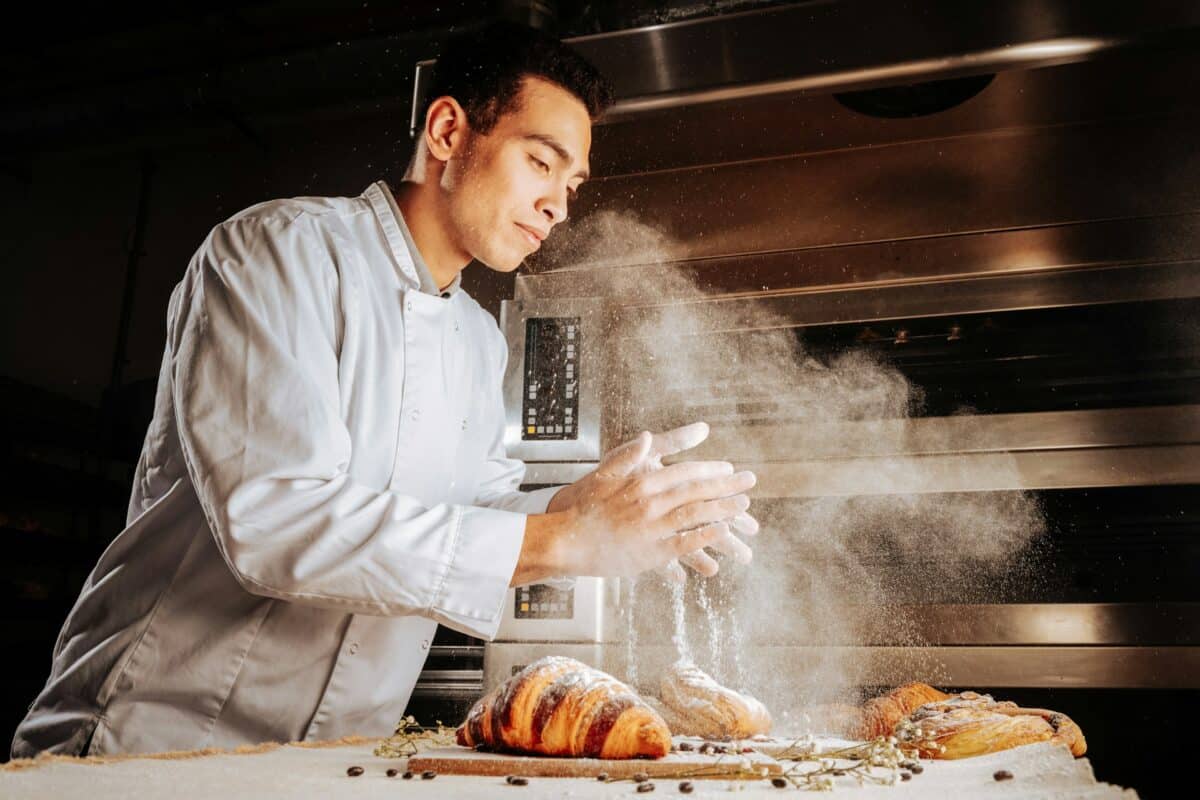
So, you’re considering starting your own bakery (or expanding your restaurant to include baked goods). Chances are that your to-do list is long, and you’re wondering if you’ve got everything accounted for as you plan your business model.
Whether you’re starting a bakery from scratch or need to size up your equipment to keep up with demand, this essential bakery equipment list will help. Here’s what you need for a thriving bakery.
The Main Oven-t: Commercial Ovens
A bakery starts with…well, baking! You need an excellent commercial oven to carry out the biggest function in your operation. For baking and pastry, you may actually need several ovens. Here’s the breakdown of commercial ovens and what they do.
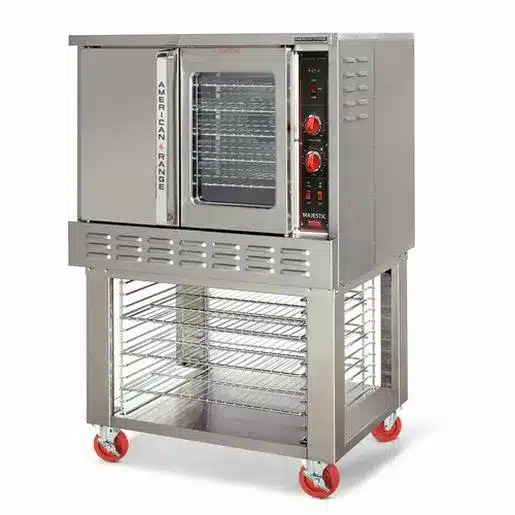
Convection Ovens: Air She Blows
A convection oven uses fans to circulate the hot air from the heating elements. The air speeds up the baking process, helping goods cook rapidly and evenly. It’s especially essential for pastries, cookies, and breads. Bonus—faster cooking times!
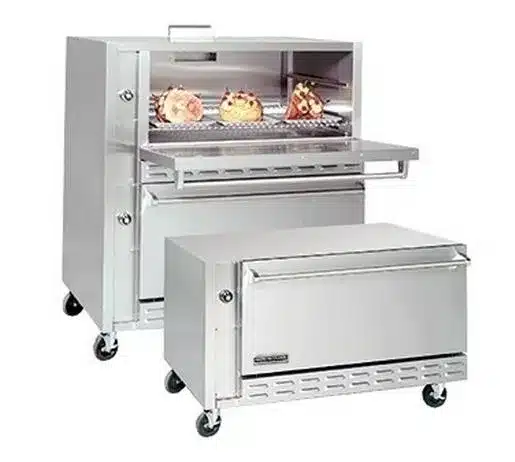
Deck Ovens: Keeping an Oven Keel
Deck ovens feature one or more flat decks. You can place items right on the surface of the deck oven to cook. These are ideal for specialty breads, pizzas, and baked goods that require direct heat. A deck oven gives you a great crust!
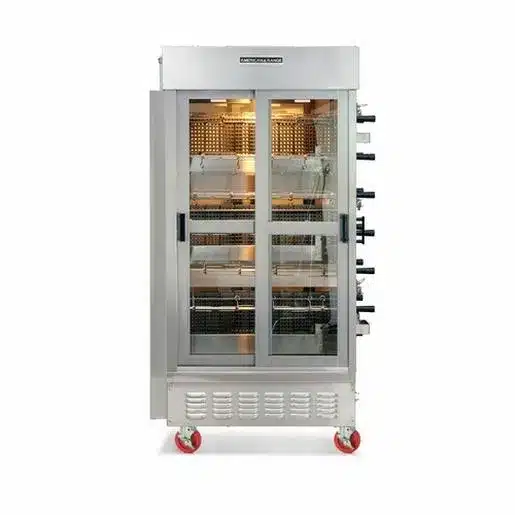
Rack Ovens: Baking Care of Business
With automatically rotating racks, rack ovens ensure that even high volumes of baked goods come out perfectly even. A rack oven is an efficient choice for mass baking. It also cuts back on the manual labor required to rotate batches.
Stone Hearth Ovens: Not a One Brick Pony
A stone hearth or “brick” oven is known for its heat-retaining natural baking surfaces. These ovens are great for artisan pizzas, rustic breads, and other items that really need that specific crust texture.
You may not need every type of oven in your kitchen, but having the right oven can especially impact your goods’ texture, crust, and baking time. For example, a convection oven ensures even-textured cakes, whereas the direct heat of a deck oven helps you get a crispy crust.
Baking times are another factor to consider. Convection ovens can significantly reduce baking time. Other ovens can take a little longer, but depending on your product, they may be ideal (speed isn’t always everything with baking).
The Ovengers: Commercial Oven Features to Explore
There are several oven features to examine if you’re deciding between commercial oven options. These are some of the key considerations:
- Temperature Control: precision is crucial in baking.
- Capacity: Can your oven’s size keep up with volume while fitting your space?
- Energy Efficiency: Some ovens are better at energy efficiency—a crucial factor for high-volume bakeries.
- Ease of Use: Look at the programmable settings and features like easy-to-clean surfaces.
- Maintenance Required: How durable is the oven, and how much regular maintenance is required?
- Versatility: Does the oven offer the versatility to bake various products at once?
Knead Answers? Understanding Mixers
Next to your oven, your commercial mixer is your next most important piece of equipment. To create commercial baked goods, you need a bakery mixer that can handle the volume (there’s no way to keep up with demand with a hand whisk). Here’s what you need to know about commercial mixer options.
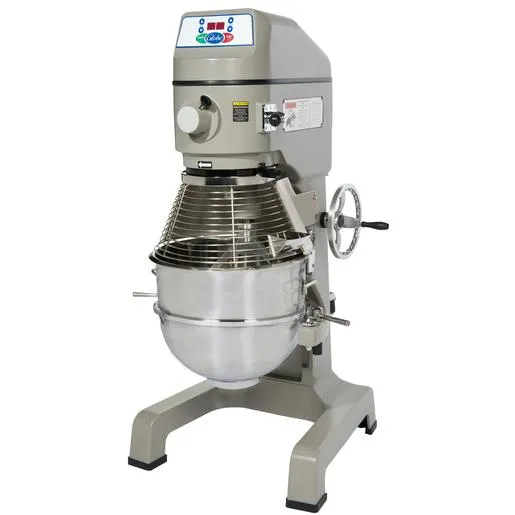
Out of this World Planetary Mixers
Planetary mixers feature an agitator rotating around a fixed bowl (like a planetary orbit). The planetary mixer is ideal for cakes, creams, light dough, pastries, and more. These machines are versatile, with an array of attachments such as whisks, dough hooks, and paddles.

Hooked on Spiral Mixers
A spiral mixer has a spiral-shaped hook, hence the name. Unlike planetary mixers, the bowl rotates while the spiral hook remains stationary. These dough mixers can handle heavy, larger quantities of dough—especially for pizza and bread. The mixing style enhances gluten development without overworking the dough.
Horizontal Mixers: Laying Down on the Job
A horizontal mixer is made for stiffer doughs like those used in bagels and pretzels. The agitator is horizontal, making it capable of handling large batches of consistent, uniform batches of dough.
You may also need handheld electric mixers for small bakery tasks. Hand mixers and food processors are the right equipment for certain tasks, even though they may not be as robust as other commercial mixers.
So, how do you choose the right mixer for the job? Look at your mixing goals—do you need a mixer that can impact air incorporation, gluten development, or steady dough temperature? These requirements will impact your choice.
You need to also consider the efficiency that your commercial kitchen requires. Mixers can speed up production significantly. If you have the right mixer, you can handle multiple batches, churning out all the delicious dough you need to keep up with customer demand.
Time to Mix and Match: Commercial Mixer Features to Explore
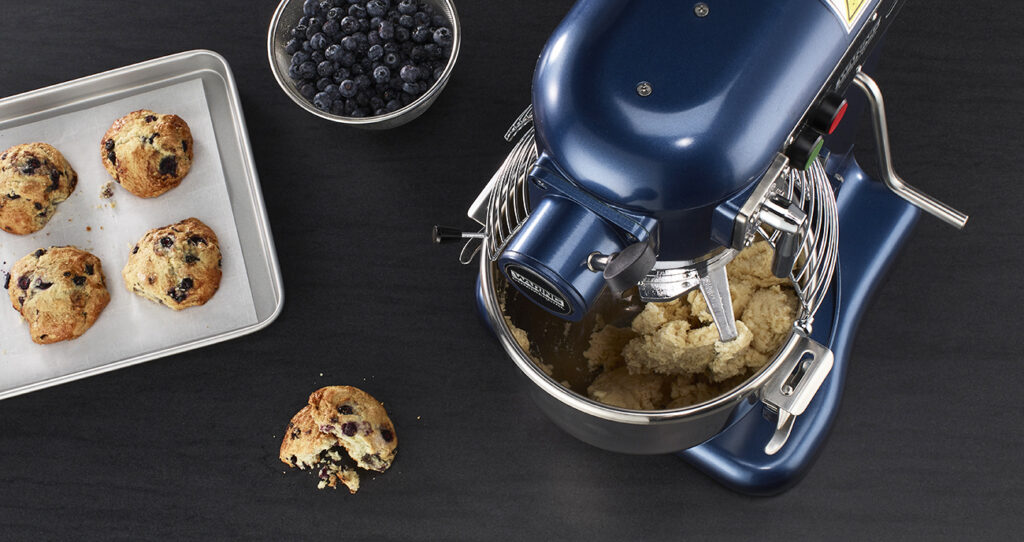
There are several important factors to consider when you’re shopping for commercial mixers. Here are the most critical features:
- Capacity and Size: Look at the volume of production needed and how the mixer will fit into the space available.
- Speed: Multiple speeds give you more control over mixing, especially for specific types of dough.
- Quality: Is the mixer built of durable materials like stainless steel?
- Safety: Mixers should feature safety guards, emergency stops, and other safety measures to prevent accidents.
- Ease of Maintenance and Cleaning: Features like removable bowls and programmable controls make it easier to mix as well as clean.
Easy Doughs It: Proofers and Retarders
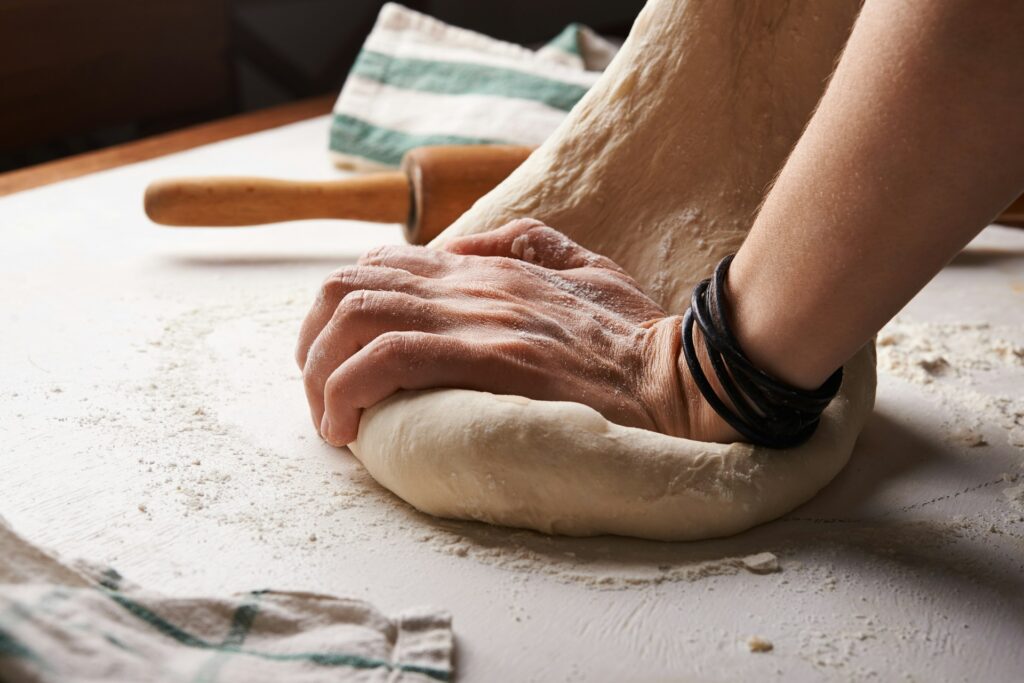
Proofing and retarding play critical roles in bread-making. The stages of proofing and retarding aren’t only about letting dough rise sufficiently, but they’re also vital for flavor development and texture.
Here’s a breakdown of these two essential baking procedures.
Understanding Proofing
Proofing is a fermentation process. It’s the step that gives bread dough a final rise before baking. Inside the bread, the yeast ferments along with the dough’s sugars, releasing tiny pockets of gas that make the dough rise. That rise gives bread the right texture and flavor.
Commercial proofers help you maintain warm temperatures and control humidity to create the perfect environment for high-quality rises. A commercial proofer is vital for achieving the desired texture and flavor in many baking applications.
Understanding Retarding
Retarding is the process of slowing down fermentation. In order to proof or rise, the dough must be warm. When placed in a controlled cold environment, the process drastically slows, allowing bakers to prepare the dough in advance.
Commercial retarders help manage workloads and provide a steady supply of oven-fresh bread throughout your day. These units refrigerate your dough to slow down yeast activity, allowing you to prepare dough in advance and overnight.
Drop-Bread Gorgeous: Combined Proofer-Retarder Units
Should you get a commercial proofer, a retarder, or a combined unit? It depends on your space and needs. A combination unity gives you more flexibility in prep and helps you manage baking schedules. If you don’t have overnight staff or need fresh bread regularly throughout the day, they can be very helpful in managing your workflow.
While there are many benefits to proofers and retarders, the combination units are often a great choice—especially for new and smaller operations. Here are a few of the advantages:
- Efficiency: A combo unit streamlines dough prep by doing it all in one.
- Space Saving: Ideal for commercial kitchens where space is at a premium.
- Flexibility: Prepare dough following your preferred schedule; don’t sacrifice quality for delayed baking.
- Consistency: Proofer and retarder combination units have consistent environmental conditions, so you’ll get the same results every time.
Baking News: Sheets, Pans, and Racks

The next must-have items on the list are your pans, sheets, and racks. Quality goes a long way when it comes to these tools. You’ll get a better result every time with high-quality sheets and pans.
With so many sheets, pans, and racks available, choosing can be challenging. Here’s what you should consider:
The Best Sheet in the House: Baking Sheets and Pans
Quality baking sheets ensure product consistency. A good sheet pan or cake pan promotes heat distribution. Using the same high-quality baking sheets and pans for each batch will give you uniform products with reliable texture and coloration.
- Shapes: Choose from a variety of standard and specialized shapes. The universal standards—rectangular, round, and square—are a must-have for cakes, cookies, and pastries. Specialized shapes include baguette pans, muffin tins, and madeleine molds.
- Materials: Aluminum pans are popular thanks to their excellent heat conductivity and durability. Aluminum pans are also lightweight and easy to handle. Stainless steel is another strong option that resists warping, although it doesn’t conduct heat quite as well as aluminum. Silicone pans and baking liners are excellent non-stick surfaces for delicate cakes and pastries. Non-stick pans reduce the need for greasing and simplify the cleanup process.
An Action-Racked Bakery: Rack Systems
Racks maximize your kitchen’s vertical space. As every culinary artist knows, space is everything when it comes to kitchen efficiency. With a quality rack system, you’ll bake more goods at once, increasing your output. Your baking area will be organized, and you’ll run into fewer errors and issues in general.
There are several types of racks and rack systems available for commercial bakeries:
- Sheet Pan Racks: Ideal for transporting flat pans and trays.
- Oven Racks: Fit inside commercial ovens, letting you bake multiple sheets and batches at once.
- Mobile Racks: These baking racks feature casters, making them easy to move around the kitchen and into the cooler.
Dough or Die: Achieving Consistency With Dough Sheeters and Dividers
Dough sheeters and dough dividers play another critical role in a high-volume bakery. Dough sheeters flatten your dough into uniform sheets (no rolling!)—ideal for pastries, pizza, flatbreads, and more. These marvelous machines reduce time, labor, and stress!
Dough dividers are essential for achieving consistent portions. Cut batches by size and weight to achieve uniform results, especially for breads, sandwich buns, and rolls. A dough divider helps your bakery business manage portioning.
The biggest benefits of adding dough sheeters and dividers to your bakery are:
- Product Consistency: Get the same size, shape, and texture every time.
- Repeatable Quality: Automation helps you avoid declining quality during peak production times.
- Increased Production Speed: Process dough much faster than rolling by hand.
- Labor Efficiency: Free up your kitchen staff for more important jobs!
Ready for Dough Processing Equipment?
Not every bakery or pastry shop needs dough processing equipment. Some types of restaurants (pizza and sandwich shops) may need dough processing gear daily. It all depends on what types of baking you’re doing. Here are a few factors to consider:
- Demand: Is your staff pushed to the limit with manual dough processing?
- Future Growth: Do you plan on expanding? Will you continue to increase capacity?
- ROI: Will the labor savings and increased production capacity offset the cost of the dough processing equipment?
- Quality: Will quality and consistency in dough help you bring in MORE dough (cha-ching)?
- Space: Do you have room for the machines in your kitchen?
- Staff: Did you consider staff training and maintenance costs?
The best thing since…sliced bread? Possibly. Bread slicers in commercial bakeries are invaluable to a consistent product presentation. If you’re making many loaves, you will almost certainly require a slicer. Manual slicing won’t produce consistent results and takes way too much time.
The Toast of the Town: Bread Slicers

There are several bread slicer machine types to choose from:
A Cut Above: Countertop Slicers
Compact and ideal for smaller bakeries and lower-volume operations, countertop slicers are great for quickly slicing standard loaves. These tools are great for cafes and boutique baking operations, where space is limited.
Slice, Slice Baby: Floor Model Slicers
A floor-model slicer can handle the volume if you produce a lot of bread. Slice all different types of bread, from rye to sourdough to whole wheat. You’ll get consistent pre-sliced loaves with minimal effort.
Slice and Easy: Automatic Slicers
If you run a large commercial bread production company, you likely need fully automated slicing machines that can handle huge quantities and multiple loaves. These types of slicers are typically used for mass production.
As with many items on this bakery equipment list, choosing the right slicer largely depends on your volume and space needs. Do you need to slice bread multiple times a day? A floor model may be a good choice. Are you slicing a loaf once in a while? A countertop slicer may be the best fit.
Dough Yourself a Favor: Bread Slicer Features to Consider
What should you consider when you’re shopping for a commercial bread slicer? Explore your options and specifically look at features like:
- Adjustable Slice Thickness: Ideal for customizing bread in restaurants and bakeries.
- Crumb Catcher: Does the machine help keep the area clean during slicing? This is particularly important for open-kitchen designs.
- Bag Spout: Some bread slicers can also bag! If you’re selling multiple loaves per day, this is a great time saver.
- Safety Guards: All types of bread slicers are sharp. Safety guards are crucial.
- Automatic Shut-off: Does the machine stop if improperly accessed or if the safety guards are removed? This can be important for safety regulations, too.
- Easy-to-Clean Surfaces: Bread slicers with smooth surfaces and minimal crevices are easier to clean and maintain.
Keeping it Cool: Refrigeration and Storage Systems
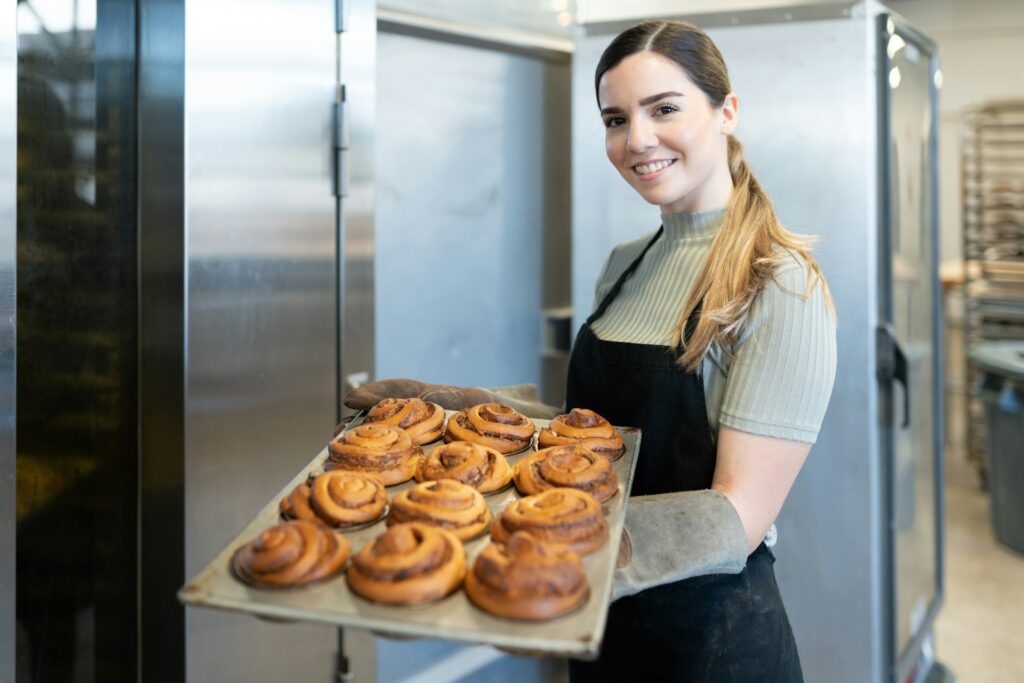
Refrigeration is another vital component of successful baking. Proper refrigeration is mandatory for the safety of ingredients like dairy, eggs, and fresh produce. Not only is it a health code requirement, but ingredients will stay fresher and safe longer with refrigeration.
Correct refrigeration also helps you extend the usability of certain dry ingredients like flour and nuts. Keep your ingredients at peak quality to prevent costly waste.
What type of refrigeration do you need? There are several options:
Status Dough: Reach-In Refrigerators
These standalone single or double-door units are ideal for many different commercial kitchens. A reach-in refrigerator allows you to accessibly store dairy and high-turnover baking ingredients at consistent temps.
The Walking Bread: Walk-In Refrigerators
Walk-ins are large, refrigerated rooms. These are ideal for large bakeries and food production companies that need to store ingredients like big sacks of flour or large quantities of produce in bulk.
Dough Faster: Blast Chillers
Blast chillers cool foods quickly by blowing air over them. These are especially useful for bakeries that make dough and fillings in advance and need to bring down the temperatures fast for storage.
Dough-n and Out: Undercounter Refrigerators
For coffee shops and smaller operations, small refrigeration units that fit under the bar or counter can keep milk, cream, and other frequently used ingredients at a constant arm’s reach.
All That Glitters Isn’t Dough: Refrigerated Display Cases
Many pastry shops need refrigerated display cases to help customers “eat with their eyes.” Show off all that gorgeous work and keep products at a safely cool temp.
Go For the Cold: Refrigerator Features to Consider
No matter what type of fridge (or fridges) you choose for your operation, keeping your refrigerator organized will maximize its use. Here are some important convenience factors to consider as you shop for refrigeration.
- Size: Size is one of the most critical factors in choosing a fridge—you need something big enough to keep all your ingredients at an optimal temperature while still fitting into your kitchen floor plan.
- Vertical Shelving: Make the most of your vertical space. Many bakery ingredients are lightweight enough to store up high. Look for refrigeration options that help you use this often empty space.
- Mobile Racking: If you use mobile bakery racks for products like cookies and cakes, look for a refrigerator solution that can accommodate the storage.
Indispens-Table Equipment: Worktables and Prep Stations
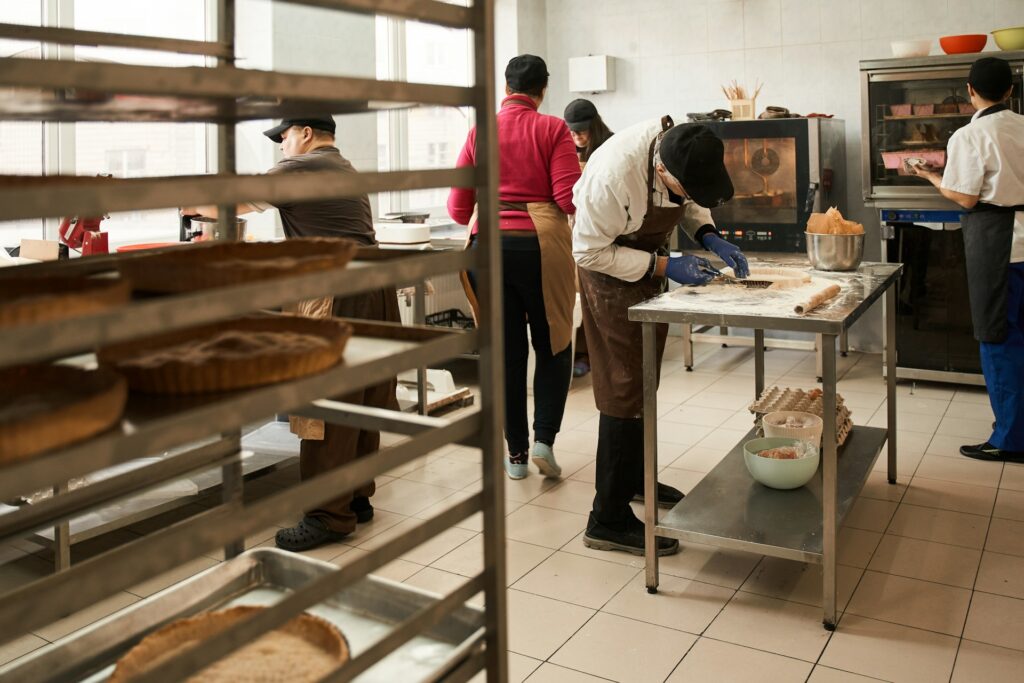
Baking is all about preparation. You need plenty of worktables and prep stations to make delectable and beautiful creations. But what are the ideal worktables and prep stations for a bakery?
Worktable Considerations
You should pay attention to a few factors when choosing an ideal worktable for your bakery. Here are the most important:
- Material: Stainless steel is the go-to answer in the kitchen; it’s durable, easy to clean, and resistant to rust and corrosion. Butcher block (wood) offers a softer surface for certain applications like dough preparation, chopping, and pounding. A sturdy table is foundational to the heart of any bakery.
- Surface Size: You’ll need adequate space for tasks on your workspace. You’ll also need to ensure that your worktables and prep stations have plenty of clearance for a busy kitchen.
- Height: Ideally, you’ll need worktables with adjustable heights to cater to different tasks and preferences.
- Built-in Storage: Do you need shelves and drawers under the table with easy access to additional equipment, tools, and ingredients? Keep pastry bags, wooden spoons, and pastry brushes handy.
- Integrated Scales: Some tables have built-in measuring features like scales and rulers.
- Customization: Modular systems can be easily arranged and offer scalability as production needs change. Dedicated stations reduce movement around the kitchen (and risk of cross-contamination) and can be equipped for special tasks like cake decorating or chocolate work.
- Ergonomics: Adjustable features can help prevent strain and injuries during baking tasks. They also make tasks more comfortable, making it easier to produce consistent products.
Flour Power: Ingredient Management with Storage Bins
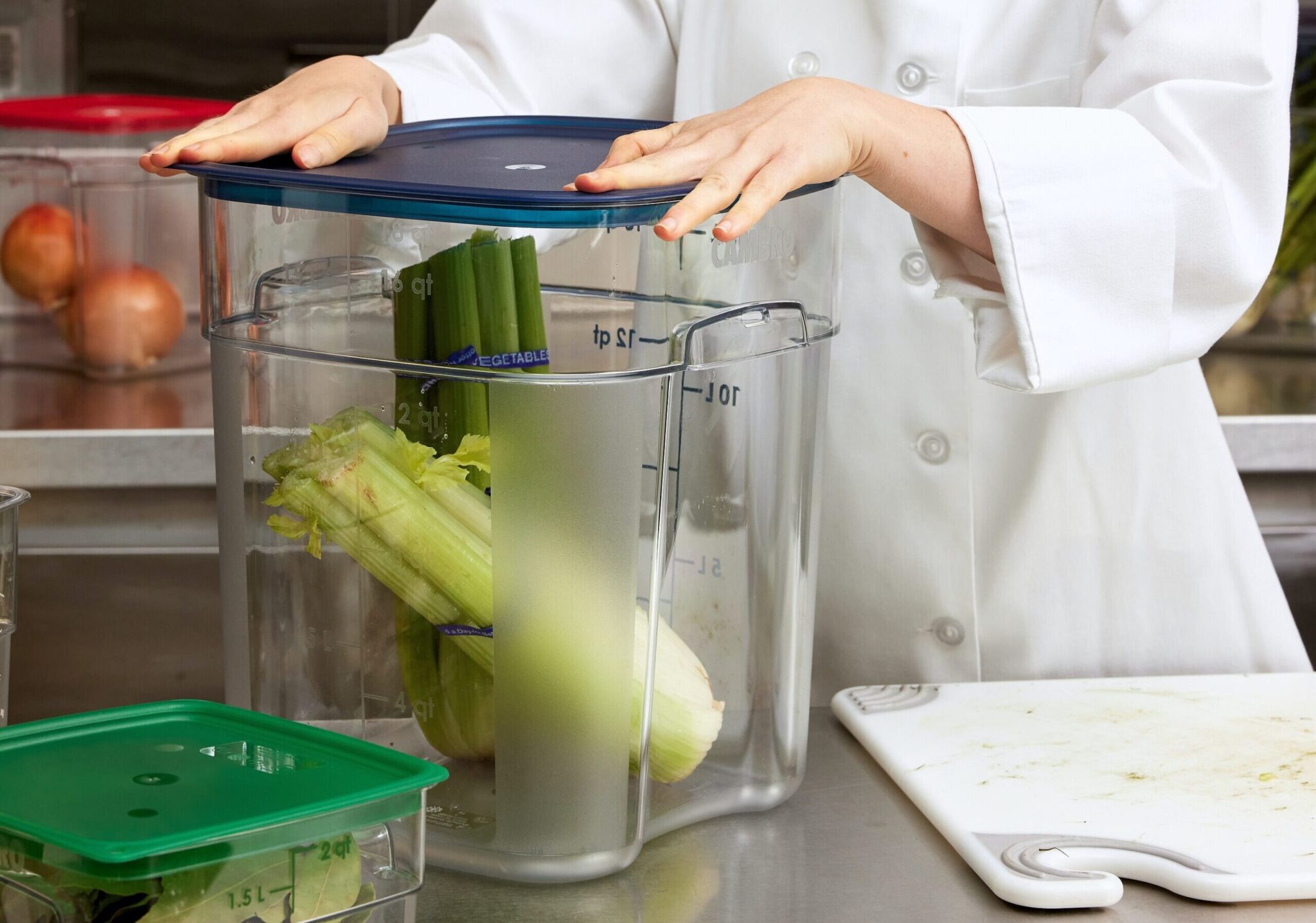
Many bakeries have to store large quantities of dry ingredients—flour, baking soda, sugar, and more. The right storage bins help you ensure that ingredients are kept fresh and readily available in your kitchen.
Several best practices should be considered when it comes to dry ingredient storage. If you’re looking for ingredient bins, here’s what you need to know before you shop.
- Proper Sealing is Crucial: Storage without proper sealing is nearly useless. Airtight seals and locking mechanisms prevent air, moisture, and pests from contaminating ingredients.
- Material Considerations: Food-grade plastics are durable and often transparent, allowing you to see what’s in the bin quickly. Metal bins can protect light-sensitive ingredients, like flour, but the metal must be lined to prevent corrosion.
- Label Systems: Are containers and bins easily labeled with crucial information like ingredient names and dates?
- Accessibility: Are the containers and bins easy to handle, even when filled with heavy ingredients?
Where to Store Bins
While your bins might store all those ingredients, you might be wondering where to store your bins! Strategic placement is everything when planning storage. How do your storage solutions integrate with your bakery layout?
- Near Points of Use: It’s generally a good idea to store ingredients near their most frequently used area.
- Cool & Dry: Certain ingredients can suffer when stored next to heat and water sources, so consider cool, dry areas in your kitchen.
- Shelving Not Stacking: Stacking bins can become a safety hazard. Ideally look for shelving that can accommodate bins without stacking them.
- Under-Counter Storage: Use space under your prep tables and countertops to keep ingredients accessible without adding clutter.
- Modular Options: As your needs change, you can adjust or expand modular storage in various shapes and sizes.
- Mobile Bins: For heavy, large quantities, mobile storage is helpful for safe moving.
- Climate Control: Some sensitive ingredients may require climate-controlled storage.
- FIFO Systems: A first-in, first-out system helps you rotate ingredients. Good storage should make this system easy and hassle-free.
The Dough Must Go On: Display Cases for Pastries and Bread
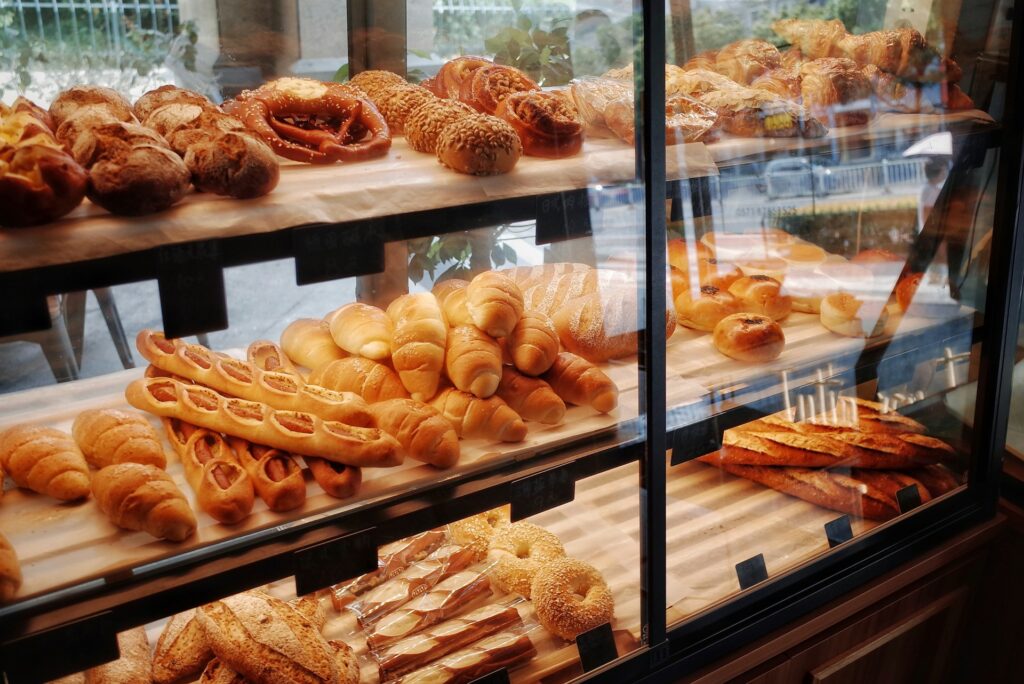
Display is an essential part of baking. Nothing tempts customers as much as beautiful cakes, mouthwatering pastries, and gorgeously textured bread. Create a feast for the eyes with a beautiful bakery display case.
While attractiveness is crucial for enticing customers, your display cases should also help preserve the freshness and quality of your product. It’s important to strike a balance between function and visual appeal.
Aesthetical and Practical Considerations in Choosing Display Cases
What should you consider as you look at display case options? Aesthetics are essential if you want to catch customers’ eyes (and cravings). Here’s what to consider when choosing display cases:
- Visual Design: The display case design should complement your interior décor and branding. Clean lines generally attract more customers and let your works of art stand out!
- Transparency: Choose cases with clear panels with unobstructed views of baked goods. Ideally, keep visuals at eye level.
- Durability: Your display counter needs to stand up to traffic, wear and tear.
- Ease of Cleaning: In food service, hygiene is everything. Your surfaces must be easy to clean.
- Lighting: Many display cases feature LED lights, with bright, even light that doesn’t emit much heat.
- Temperature: Display cases require temperature control, especially for pastries and other morsels that must be kept below room temps.
- Humidity: Without proper humidity, pastries can quickly wither or become soggy. Display cases may need humidity control features to keep products at optimal levels.
- Presentation is Everything: Presentation is paramount in baking. Displays should be eye-level, well-lit, clean, and appealing. Strategic presentations can highlight special items and encourage impulse purchases.
Regularly rotate products and pull back anything that looks less-than-perfect. A varied selection encourages customers to buy more, so as you display items, group them and use spacing to your advantage.
Doughn’t Be Gross: Cleaning and Sanitation Supplies

Sanitation is imperative in any food preparation. Health codes and industry standards set the baseline, but successful operations go the extra mile. It’s important to look closely at the workflow to assess where contamination risks are highest—often mixing and shaping stations. Establish protocols and regular routines to minimize risk.
Like decorating the perfect cake, the right tools for the job will take you far. Having the right cleaning supplies for your bakery will make sanitizing easier. Here’s what you should have on hand:
A Cookie Mistake: Food Prep Areas
You’ll need food-safe disinfectants and sanitizers in your food preparation areas. The goal is to eliminate pathogens without leaving behind any residue. You will also need non-abrasive scrubbers and microfiber cloths that won’t damage stainless steel and other food preparation surfaces.
A Real Deal Baker: Baking and Cooking Equipment
To keep your specialty equipment clean, you’ll need specialized cleaners. Oven cleaners can cut through tough grease and baked-on bits without damaging or corroding metal parts. Your mixer and other equipment need daily cleaning of all surfaces to prevent food-borne illness and reduce wear and tear from food particles and residue.
Spic and Pan: Floors and Non-Food Areas
Your floor must be kept clean so it can handle the heavy traffic of your bakery. Oil, flour, and other materials quickly become slipping hazards. Sanitizing floor mats at entry points will help reduce the spread of outside contaminants. The floor should be mopped daily with a disinfectant cleaner, and spills should be addressed immediately.
Creating a clear cleaning schedule is the easiest way to keep your kitchen up to health code standards. Break down tasks into frequency—what should employees do after each use, after each shift, and at the end of each day?
At a minimum, all surfaces should be sanitized after each use, and the floor should be swept and mopped daily. Schedule weekly deep cleanings of equipment and hard-to-reach areas. Review your cleaning schedules weekly and conduct an inventory check. Documentation will help you prepare for any surprised inspections or concerns.
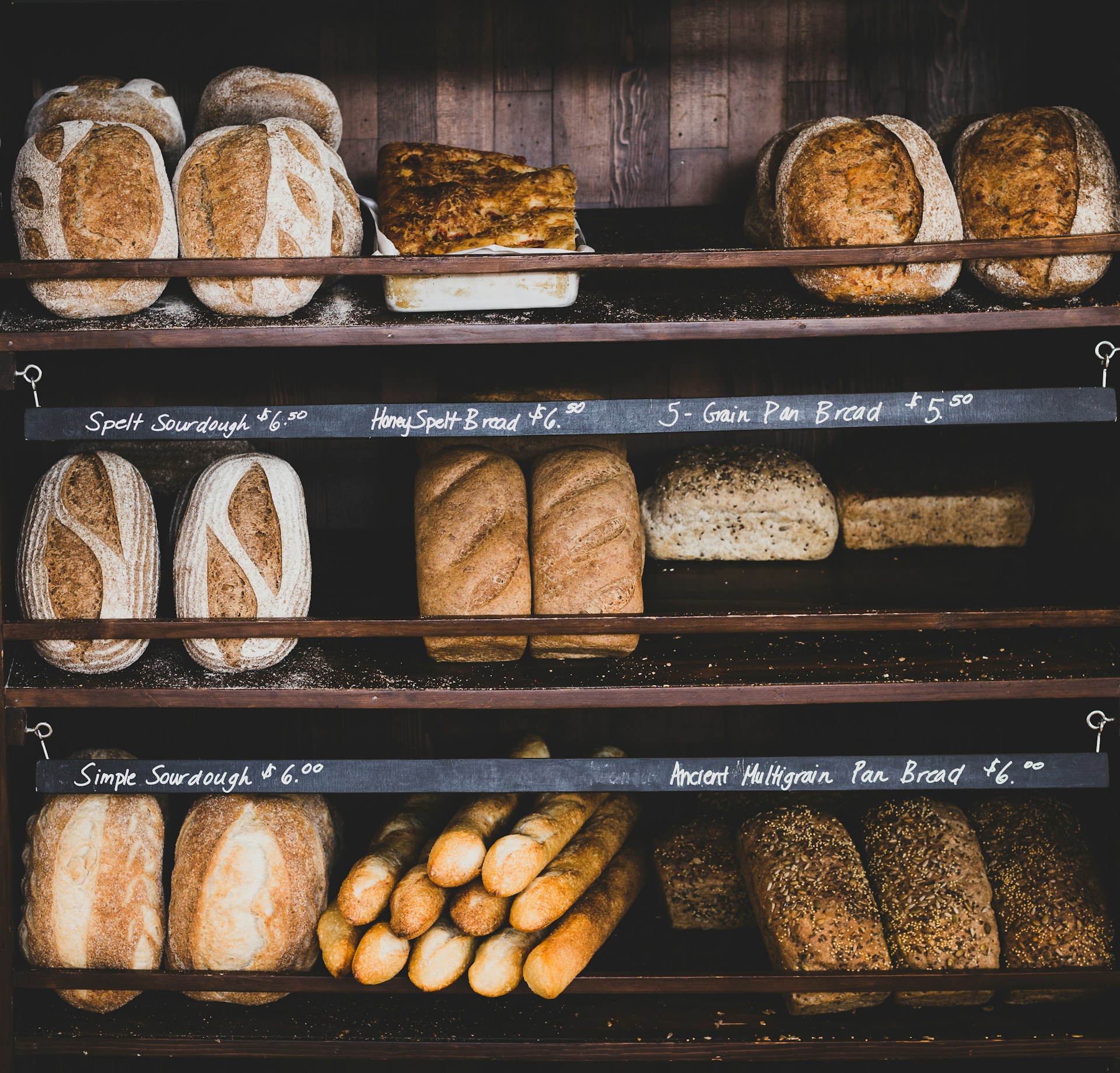
Cheaper by the Oven: Equip Your Bakery at Eleven36
At Eleven36, you’ll find everything you need to equip your bakery, from ovens to mixers to refrigerated display cases. We carry the best equipment in the culinary industry. The quality of your baked goods depends on having the right kitchen equipment for every task.
At a minimum, most bakeries will need:
- Ovens
- Mixers
- Refrigeration
- Work Surfaces
- Storage
- Cleaning Supplies
In many cases, you may also need:
- Proofers and Retarders
- Baking Racks
- Dough Sheeters
- Bread Slicers
- Refrigerated Display Cases
It’s important to invest in high-quality equipment to save dough in the long run. Quality equipment lays the foundation for your baking industry success and helps you create beautiful, delectable culinary delights.Whether expanding your current operations or starting up a bakery from scratch, we can show you the right bakery equipment for the job. Reach out today to discuss your commercial kitchen needs. We’ll help you create something truly delicious!
